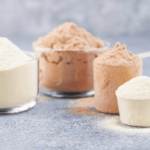
Tiana Hape-Cramond
(Associate Registered Nutritionist)
Jump to:
- What is Vitamin B5?
- Vitamin B5 deficiency
- Different types of Vitamin B5
- Health Benefits
- Health Claims
- Best sources of Vitamin B5
- Daily requirements and intake
- How to take Vitamin B5
- Signs and symptoms of deficiency
- Risks and side effects
- Interactions - herbs and supplements
- Interactions - medication
- Summary
- Related Questions
Vitamin B5 is not often talked about and yet its presence in the diet is crucial for several everyday functions in our body.
Some of the health benefits of taking vitamin B5 and having above average levels can include
- More energy
- Lower levels of cholesterol
- More robust immunity
- Lower levels of stress
- Better athletic performance
If you would like to find out more about vitamin B5 and whether it should be included in your daily diet, either as a supplement or through foods high in vitamin B5, we suggest scrolling down and continuing with the article.
What is Vitamin B5?
Vitamin B5, also known as pantothenic acid, is a water-soluble vitamin that helps to break down the food we eat into energy.
Vitamin B5 was initially discovered by chemist Roger Williams in 1931 during his study on B vitamins and yeast, where he came across an unidentified nutrient that stimulated the growth in yeast.
In 1933, he named it “panthos” which is Greek for “everywhere”.
This discovery led to experiments on animals with pantothenic acid deficiency, which highlighted its fundamental importance, receiving the classification of vitamin.[1,2]
In 1954, Bean and Hodges reported that pantothenic acid was essential in human nutrition, which prompted investigations of the pantothenic acid deficiency in healthy humans.[1] In the 1960s, pantothenic acid was identified as an important nutrient in fatty acid synthesis.
The uses for vitamin B5 are growing as the research continues, while the studies so far have discovered many benefits, which are discussed in the following sections.
Vitamin B5 deficiency
It is very rare to have a pantothenic acid deficiency as vitamin B5 is present in some form in almost all foods. A fresh and varied diet should provide the recommended daily amount.
RELATED — The Healthy Plate Model: Essentials of Healthy Eating
Who is most at risk of Vitamin B5 deficiency?
People with severe malnutrition
People who have severe malnutrition are at risk of vitamin B5 deficiency as they are not consuming enough food to provide their bodies with the required daily nutrients.[3] This also includes individuals with eating disorders.

Alcohol abuse and addiction
Individuals with chronic alcoholism have a higher risk of developing vitamin B5 deficiency. This is due to alcohol-depleting vitamin B5 in the cells.
Another theory for the increased risk of vitamin B5 deficiency is that chronic alcoholics are also at a higher risk of malnutrition.[1]
People with a genetic mutation
People who have a mutation on their pantothenate kinase 2 (PANK2) are more likely to develop vitamin B5 deficiency.
This mutation decreases the conversion of pantothenic acid to coenzyme A (CoA), which leads to decreased levels.[3]
Different types of Vitamin B5
Vitamin B5 can be found in four different forms:
- D-pantothenic acid
- Dexpanthenol
- Calcium pantothenate
- Pantethine
D-pantothenic acid
D-pantothenic acid is a sodium salt form of the biologically active form vitamin B5 and is used in the synthesis of coenzyme A.[4]
D-pantothenic acid is used to make D-calcium pantothenate, which is the form most used in supplements. These supplements are used for mental function, cognition and stress support.
Dexpanthenol
This form of vitamin B5 is chemically similar to pantothenic acid as it is made from D-pantothenic acid. It can be used for wound healing, skin irritation and nasal swelling.
This form of vitamin B5 is known to have good penetration for absorption and is used in a topical form to relieve itching and aid in the healing process.[5]

Calcium pantothenate
Calcium pantothenate is the calcium salt of the vitamin B5 and can be found in plants and animal tissues with antioxidant properties.[6]
This form of vitamin B5 can be found in multivitamins or complex B vitamins and nail and hair health vitamins.[7]
Pantethine
Pantethine is a naturally occurring compound that is synthesised in the body from pantothenic acid.[8]
Pantethine lowers cholesterol levels
Research has found that vitamin B5 in this form is retained in the blood longer than other forms of vitamin B5, but the absorption rate is similar to that of calcium pantothenate.[9]
Important note — Calcium pantothenate is the most common form commercially sold and most convenient regarding the price, while pantethine, which is more expensive, seems to offer additional health benefits.
Health benefits of Vitamin B5
Vitamin B5 is an important vitamin that has many functions with the most important ones being the production of red blood cells and sex and stress-related hormones.
Converting food into glucose
Vitamin B5 assists in the conversion of food to glucose, which is used for energy.[10]
Synthesising cholesterol and metabolising fats
Pantothenic acid is used to break down fats and has been studied for its potential effects in reducing cholesterol.
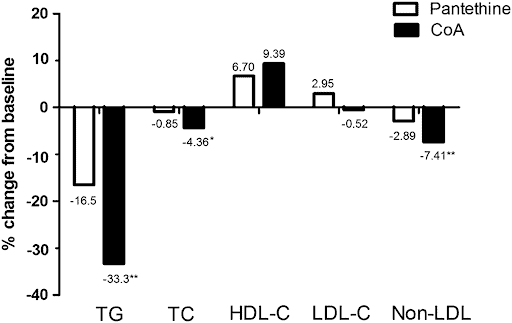
Source: Zhao YH. Efficacy and tolerability of coenzyme A vs pantethine for the treatment of patients with hyperlipidemia: A randomized, double-blind, multicenter study. Journal of clinical lipidology. (2015)
A study followed both men and women who had moderate dyslipidemia (imbalance of cholesterol) that were given coenzyme A (CoA), which is the enzyme made using vitamin B5.
They found that those receiving CoA had a 33% reduction in triglycerides compared to baseline.[11]
Forming sex and stress-related hormones
Vitamin B5 is an essential precursor to acetyl-CoA, which is used to form all the hormones secreted by the adrenal gland. These hormones include
- Cortisol
- Norepinephrine
- Adrenaline
- Testosterone
- Progesterone[12]
Forming red blood cells
We mentioned the importance of CoA, and one of its functions is to create porphyrin, which is a part of the pigment in haemoglobin, the heme molecule and red blood cells.[13]
Synthesising coenzyme A
Vitamin B5 is the key precursor for the synthesis of coenzyme A, which is used in the synthesis of fatty acids and is an important factor in converting foods into fatty acids and cholesterol.[14]
Maintaining a healthy digestive system
Gut bacteria require vitamin B5 for fatty acid and biotin metabolism.
Dietary supplementation of pantothenic acid influences the gut microbial profile by increasing prevotella and actinobacteria.[15] Actinobacteria is used for development and maintenance of gut homeostasis, and prevotella may be beneficial for healthy microbiota.
Also, in the case of yeast overgrowth such as Candida albicans, which produces waste products such as acetaldehyde, pantethine is used to relieve symptoms of acetaldehyde poisoning by lowering the amount of acetaldehyde in the blood.[16]
Skin health
Pantothenic acid has been known to have a positive influence on fibroblasts and keratinocytes which are involved in the healing process.
Vitamin B5 creates a moisturising skin barrier that prevents skin irritation and promotes regeneration.[17]
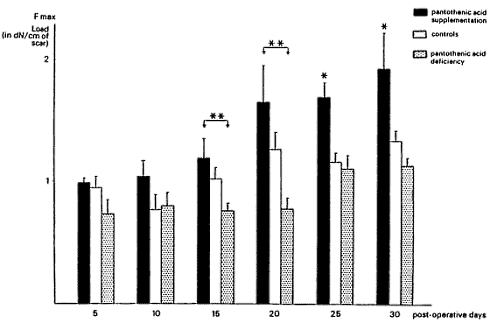
Source: Grenier, J.F. Effects of supplemental pantothenic acid on wound healing: experimental study in rabbit. (1985)
The figure above shows that pantothenic acid supplementation can aid in the healing of tendons. The tendons recovered faster in the supplemented group than the control group.[18]
Pantothenic acid can be used to reduce acne
Vitamin B5 works by reducing the oil production of the sebaceous glands.[19] A study found that taking pantothenic acid for 12 weeks is safe and reduces total facial lesions as shown in the chart below.[20]
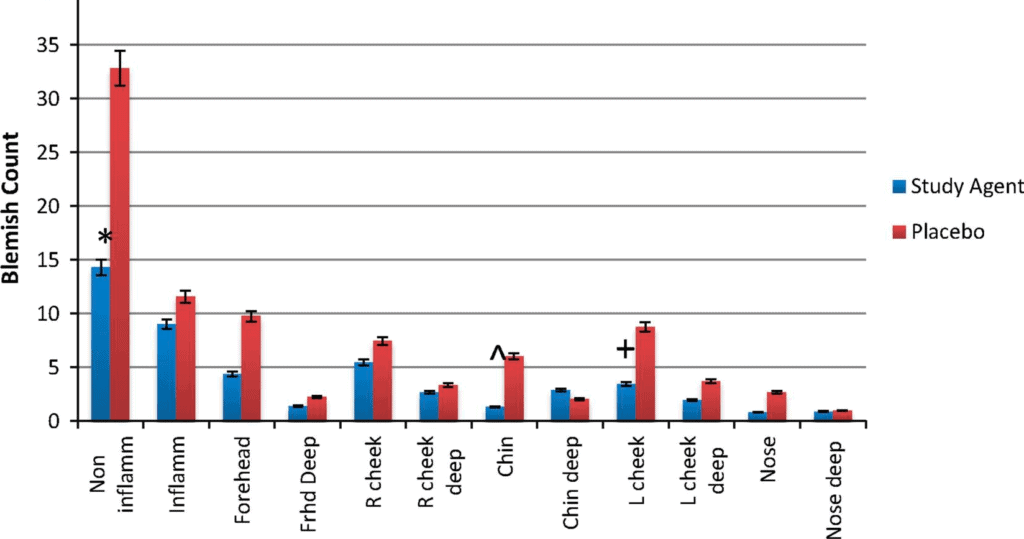
Source: Capodice J. A randomized, double-blind, placebo-controlled study of a novel pantothenic acid-based dietary supplement in subjects with mild to moderate facial acne. Dermatology and therapy. (2014)
Lowering cholesterol and triglycerides levels
Vitamin B5 can help create a balance for “good” and “bad” cholesterol. In a clinical trial, vitamin B5 was given to those with high cholesterol and found that their levels significantly decreased.[21]
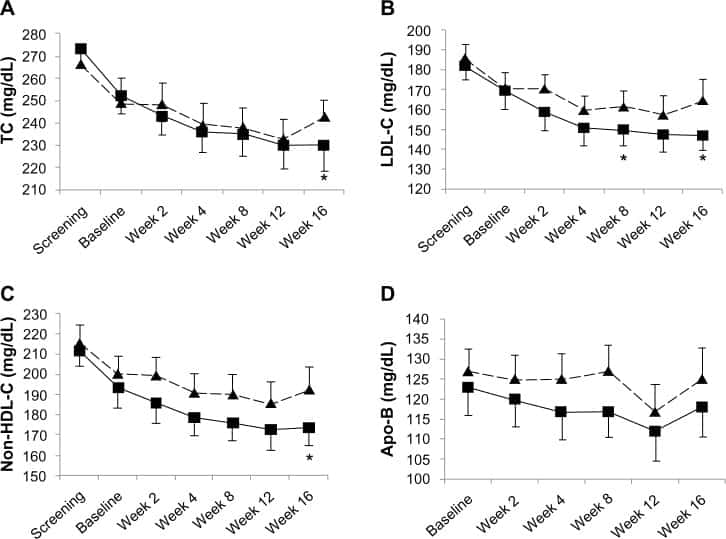
Inflammation and rheumatoid arthritis
In animal studies, rats with pantothenic acid deficiency had defects in the growth and development of bone and cartilage that were reversed with the supplementation of vitamin B5.[22]
In a clinical study using pantothenic acid on those with rheumatoid arthritis, it was found that it relieved some symptoms.[23]
Health claims that still need more evidence and research
Athletic performance
The human studies around the effect of vitamin B5 on athletic performance are mixed.
One study found that athletes taking pantothenic acid supplements used 8% less oxygen and 17% had less lactic acid accumulation. However, in another study, these figures were not replicated.[24]
Improved immunity
Vitamin B5 triggers an immune cell response to produce cytokines. The means that the potential for pantothenic acid to decrease inflammation and amend immune system damage should be considered.[25]
Treatment for diabetes
Diabetes tends to lower HDL cholesterol and increase triglycerides, a condition that is called diabetes dyslipidemia.
Pantothenic acid was investigated for its use in the treatment of diabetes for its cholesterol-lowering properties. One study found there may be some use for pantothenic acid to lower cholesterol and prevent diabetes dyslipidemia.[26]
RELATED — Diabetes: Early Signs, Causes, Types and Treatment
Stress
Vitamin B5 has the potential to be more widely used in reducing biological damage of stress. Stress causes the secretion of cortisol, and this is where an adequate amount of vitamin B5 can downregulate this mechanism of action.[27]
Vitamin B5 is known as the anti-stress vitamin
Alleviating ADHD symptoms
It is theorised that vitamin B5 may help with ADHD by easing stress, irritability and other symptoms.[28]
However, studies using multivitamins did not find sufficient evidence to support this, so more research is needed.[29]
Heart health
Through the vitamin B5 function in lowering cholesterol, it may also be improving heart health and decreasing the risk of developing heart failure.[30]
Heart-healthy diets include foods rich in HDL and foods with low LDL. Vitamin B5 can be used to lower cholesterol and triglycerides, which are known to improve heart function.
Allergies
When used as a natural remedy for hayfever, vitamin B5 was found to reduce allergen reactions as it reduces nasal congestions.[31]
A study found that using dexpanthenol as a nasal spray after three days leads to improvement of symptoms.[32]
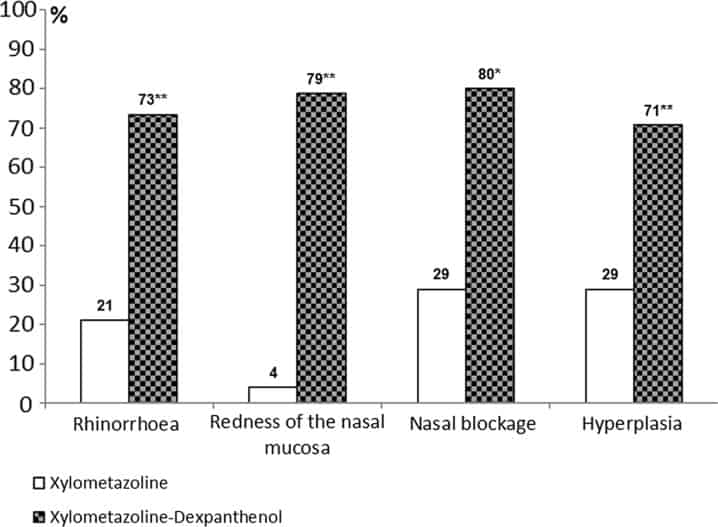
Healthy skin, hair and eyes
In a study that involved mice deficient in vitamin B5, the researchers noted skin irritation and greying of fur, which was then reversed when vitamin B5 was administered.
However, there is limited evidence for preventing or restoring hair colour in humans.[33]
Important note — People may also be taking vitamin B5 for asthma, colitis, conjunctivitis, convulsions, depression, Parkinson’s disease and yeast infections, but there is limited evidence to support this.
Best sources of Vitamin B5
Top food sources of pantothenic acid are listed below.
Food Source | Concentration (mg/100g) | Daily Value (DV) Men / Women |
Shiitake mushrooms (dried) | 21.9mg | 365% / 547% |
Chicken liver | 6.6mg | 111% / 166% |
Whey protein | 5.8mg | 96% / 145% |
Yeast extract spread (Marmite) | 4.6mg | 76% / 115% |
Abalone | 2.8mg | 47% / 71% |
Chicken heart | 2.6mg | 44% / 66% |
White button mushroom | 2.1mg | 36% / 54% |
Peanuts | 1.7mg | 29% / 44% |
Lobster | 1.6mg | 27% / 41% |
Beef kidney | 1.5mg | 26% / 39% |
Roast duck | 1.5mg | 25% / 37% |
Eggs | 1.4mg | 23% / 35% |
Avocado | 1.3mg | 23% / 34% |
Camembert cheese | 1.3mg | 22% / 34% |
Pork chop | 1.1mg | 19% / 28% |
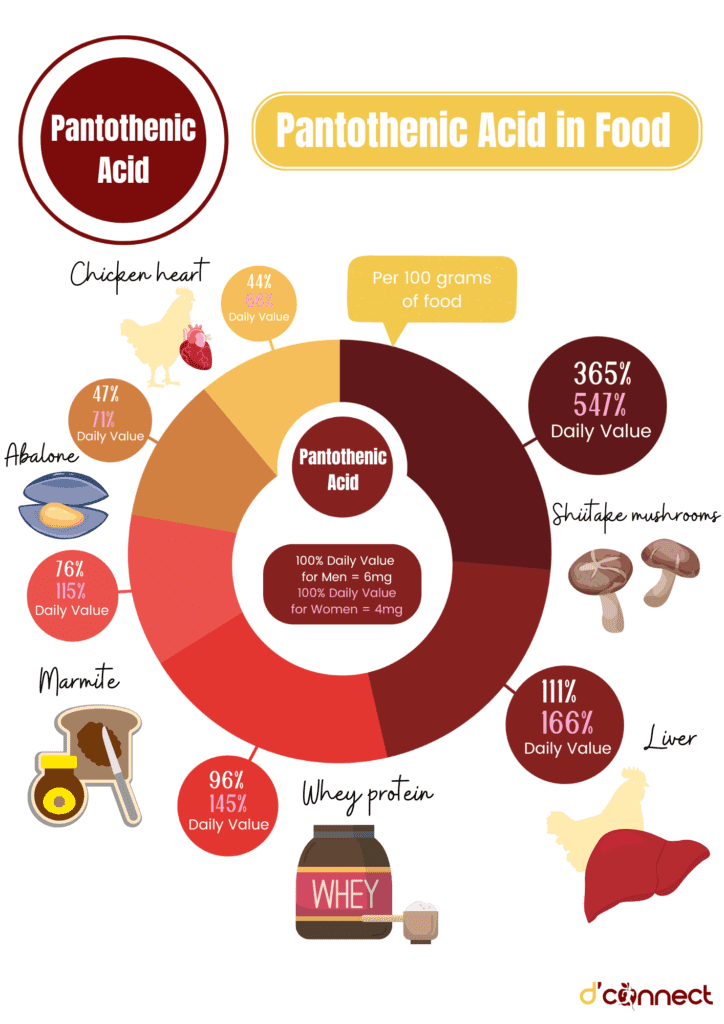
Important note — Pantothenic acid is present in a variety of foods. The richest dietary sources include mushrooms and animal products, such as meat and dairy.
Daily requirements and recommended intake
As there is limited data, an estimated average recommendation (EAR) and adequate intake (AI) was set for age groups and genres using the median population intake data from Australian and New Zealand populations.[34]
Age | Male | Female |
0-6 months | 1.7mg | 1.7mg |
7-12 months | 2.2mg | 2.2mg |
1-3 years | 3.5mg | 3.5mg |
4-8 years | 4mg | 4mg |
9-13 years | 5mg | 4mg |
14-18 years | 6mg | 4mg |
19-30 years | 6mg | 4mg |
31-50 years | 6mg | 4mg |
51-70 years | 6mg | 4mg |
>70 years | 6mg | 4mg |
Pregnant and lactating women should add an additional 1 mg to 2 mg of vitamin B5 to their diet or supplementation.
How to take Vitamin B5 as a supplement
Pantothenic acid supplements are available only as pantothenic acid (including all forms: D-pantothenic acid, dexpanthenol, calcium pantothenate, pantethine) and a combination with other B-complex vitamins and multivitamin products.
The amount in supplements typically ranges from 10mg to 1000mg.[35] It is recommended to take vitamin B5 on an empty stomach.
Common signs and symptoms of Vitamin B5 deficiency
Vitamin B5 deficiency is very rare in people eating a variety of foods, but it is recommended to be aware of signs and symptoms.
Some of the symptoms of vitamin B5 deficiency are
- Headache
- Malaise
- Personality changes
- Muscle cramps
- Impaired muscle coordination[36,37]
Vitamin B5 can become depleted after prolonged hyperactivity
This is due to adrenal gland activity and increased production of cortisol, which can then result in insomnia and other sleep disturbances.[38]
Important note — Nearly all symptoms of vitamin B5 deficiency can be reversed by vitamin B5 supplementation.
Vitamin B5 risks and side effects
When taking large doses of vitamin B5, the most common side effects are dry skin, mild diarrhoea and gastrointestinal distress.
With extremely high doses (10-20g a day) there is an increased risk of bleeding. Also, we need to remind ourselves that when taking any vitamin in excess quantities, it can cause an imbalance in other B vitamins.[39]
Possible interactions with herbs and supplements
Pantothenic acid taken in large doses may have an interaction with biotin as they may compete for intestinal and cellular uptake.[33]
Possible interactions with medications
Vitamin B5 can interact with some drugs.
Pantothenic acid may have an adverse interaction with antibiotics such as
- Erythromycin
- Azithromycin
- Clarithromycin
- Tetracycline
by inhibiting their absorption and effectiveness.[3]
Oral contraceptives containing oestrogen and progestin may increase the pantothenic acid requirements.[1]
Vitamin B5 may also increase the effect of cholinesterase inhibitors, which are used for Alzheimer’s disease. These drugs include donepezil, memantine hydrochloride, galantamine and rivastigmine.[40]
Summary
Whole grains can be a good source of vitamin B5, but the milling process can remove up to 75% of vitamin B5 content.
Vitamin B5 is a water-soluble vitamin, which means that nutrients may be lost when the food is boiled.
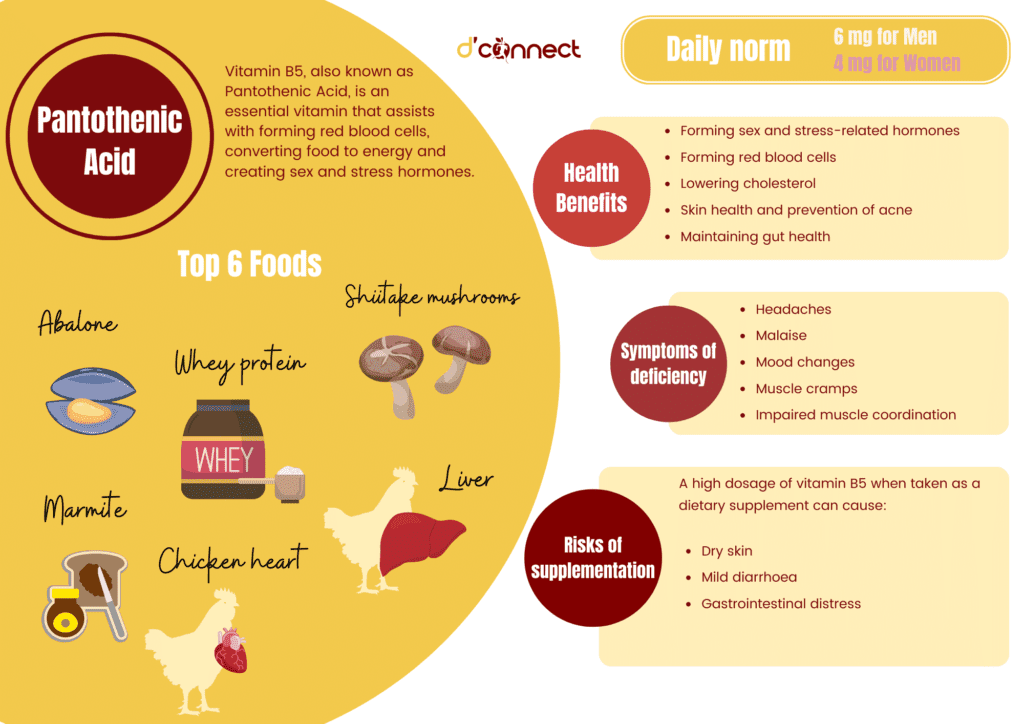
Key Takeaway — In this summary illustration we have outlined the most important information that you should know about Pantothenic acid (vitamin B5).
Related Questions
1. How common is pantothenic acid deficiency?
Vitamin B5 deficiency is not common as pantothenic acid is found in a variety of foods. Vitamin B5 deficiency is mostly found in those who are severely malnourished or have a genetic condition.[3]
2. How long does it take for pantothenic acid to clear acne?
For pantothenic acid to help with acne it will take 12 to 16 weeks to see a noticeable difference on the skin.[42]
3. Does pantothenic acid reduce inflammation
Dietary intake of pantothenic acid was seen to decrease low-grade inflammation. However, more evidence is needed.[43]
If you have just joined in and are interested in learning more about B vitamins, we suggest starting with Vitamin B1 (Thiamine).
References
(1) Vitamin B5 (Pantothenic acid) [Internet]. Available from: https://www.dsm.com/content/dam/dsm/meat-alternatives/documents/Vitamin-B5.pdf
(2) Hrubša M, Siatka T, Nejmanová I, Vopršalová M, Kujovská Krčmová L, Matoušová K, Javorská L, Macáková K, Mercolini L, Remião F, Máťuš M. Biological properties of vitamins of the B-Complex, part 1: vitamins B1, B2, B3, and B5. Nutrients. 2022 Jan 22;14(3):484. Available from: https://www.ncbi.nlm.nih.gov/pmc/articles/PMC8839250/
(3) Sanvictores T, Chauhan S. Vitamin B5 (Pantothenic Acid) [Internet]. Nih.gov. StatPearls Publishing; 2022 [cited 2022 Sep 21]. Available from: https://www.ncbi.nlm.nih.gov/books/NBK563233/
(4) D-Pantothenic Acid (sodium salt) [Internet]. Caymanchem.com. Cayman; 2022 [cited 2022 Sep 19]. Available from: https://www.caymanchem.com/product/17288/d-pantothenic-acid-(sodium-salt)
(5) Dexpanthenol: Uses, Interactions, Mechanism of Action | DrugBank Online [Internet]. Drugbank.com. DrugBank; 2020 [cited 2022 Oct 9]. Available from: https://go.drugbank.com/drugs/DB09357
(6) PubChem. Calcium pantothenate [Internet]. @pubchem. PubChem; 2022 [cited 2022 Oct 9]. Available from: https://pubchem.ncbi.nlm.nih.gov/compound/Calcium-pantothenate#section=General-Manufacturing-Information
(7) Pantothenic Acid (Vitamin B5): Overview, Uses, Side Effects, Precautions, Interactions, Dosing and Reviews [Internet]. Webmd.com. 2012 [cited 2022 Oct 9]. Available from: https://www.webmd.com/vitamins/ai/ingredientmono-853/pantothenic-acid-vitamin-b5#:~:text=Vitamin%20B5%20is%20available%20as,acid%20for%20pantothenic%20acid%20deficiency
(8) Evans M, Rumberger JA, Azumano I, Napolitano JJ, Citrolo D, Kamiya T. Pantethine, a derivative of vitamin B5, favourably alters total, LDL and non-HDL cholesterol in low to moderate cardiovascular risk subjects eligible for statin therapy: a triple-blinded placebo and diet-controlled investigation. Vascular health and risk management. 2014;10:89.
(9) European Food Safety Authority. Pantethine as source for pantothenic acid added as a nutritional substance in food supplements – Scientific Opinion of the Panel on Food Additives and Nutrient Sources added to Food (ANS). EFSA Journal. 2008 Nov;6(11):865. Available from: https://efsa.onlinelibrary.wiley.com/doi/pdfdirect/10.2903/j.efsa.2008.865
(10) Tardy A-L, Pouteau E, Marquez D, Yilmaz C, Scholey A. Vitamins and Minerals for Energy, Fatigue and Cognition: A Narrative Review of the Biochemical and Clinical Evidence. Nutrients [Internet] 2020;12(1):228. Available from: http://dx.doi.org/10.3390/nu12010228
(11) Chen YQ, Zhao SP, Zhao YH. Efficacy and tolerability of coenzyme A vs pantethine for the treatment of patients with hyperlipidemia: A randomised, double-blind, multicenter study. Journal of clinical lipidology. 2015 Sep 1;9(5):692-7.
(12) Pizzimenti N, Ervin JD. Vitamin B5-Aides in Energy Production.
(13) PubChem. Porphyrin Metabolism [Internet]. PubChem; 2022 [cited 2022 Oct 8]. Available from: https://pubchem.ncbi.nlm.nih.gov/pathway/PathBank:SMP0087336
(14) Leonardi R, Jackowski S. Biosynthesis of Pantothenic Acid and Coenzyme A. EcoSal Plus. 2007 Apr;2(2):10.1128/ecosalplus.3.6.3.4. doi: 10.1128/ecosalplus.3.6.3.4. PMID: 26443589; PMCID: PMC4950986
(15) Hossain KS, Amarasena S, Mayengbam S. B Vitamins and Their Roles in Gut Health. Microorganisms. 2022 Jun 7;10(6):1168. Available from: https://www.mdpi.com/2076-2607/10/6/1168
(16) Watanabe A, Hobara N, Kobayashi M, Nakatsukasa H, Nagashima H. Lowering of blood acetaldehyde but not ethanol concentrations by pantethine following alcohol ingestion: different effects in flushing and non-flushing subjects. Alcohol Clin Exp Res. 1985 May-Jun;9(3):272-6. doi: 10.1111/j.1530-0277.1985.tb05748.x. PMID: 3893199.
(17) Gheita, Alaa A.; Gheita, Tamer A.; Kenawy, Sanaa A. (2019). The potential role of B5: A stitch in time and switch in cytokine. Phytotherapy Research, (), ptr.6537–. doi:10.1002/ptr.6537
(18) Hefty dose of vitamin B5 helps damaged tendons heal quicker [Internet]. Ergo-log.com. 2015 [cited 2022 Oct 9]. Available from: https://www.ergo-log.com/vitamin-b5-tendons.html
(19) Dach J. Pantothenic Acid, Vitamin B5 for Acne.
(20) Yang M, Moclair B, Hatcher V, Kaminetsky J, Mekas M, Chapas A, Capodice J. A randomized, double-blind, placebo-controlled study of a novel pantothenic acid-based dietary supplement in subjects with mild to moderate facial acne. Dermatology and therapy. 2014 Jun;4(1):93-101.
(21) Evans M, Rumberger JA, Azumano I, Napolitano JJ, Citrolo D, Kamiya T. Pantethine, a derivative of vitamin B5, favorably alters total, LDL and non-HDL cholesterol in low to moderate cardiovascular risk subjects eligible for statin therapy: a triple-blinded placebo and diet-controlled investigation. Vascular health and risk management. 2014;10:89.
(22) Miller, Joshua W. (2020). Present Knowledge in Nutrition || Pantothenic acid. , (), 273–287.
doi:10.1016/B978-0-323-66162-1.00016-0
(23) Barton-Wright EC, Elliott WA. The pantothenic acid metabolism of rheumatoid arthritis. Lancet. 1963;2:862-3.
(24) Litoff D, Scherzer H, Harrison J. Effects of pantothenic acid supplementation on human exercise. Med Sci Sports Exerc. 1985;17(suppl):287.
(25) He W, Hu S, Du X, Wen Q, Zhong XP, Zhou X, Zhou C, Xiong W, Gao Y, Zhang S, Wang R. Vitamin B5 reduces bacterial growth via regulating innate immunity and adaptive immunity in mice infected with Mycobacterium tuberculosis. Frontiers in immunology. 2018:365.
(26) Naruta E, Buko V. Hypolipidemic effect of pantothenic acid derivatives in mice with hypothalamic obesity induced by aurothioglucose. Experimental and toxicologic pathology. 2001 Jan 1;53(5):393-8.
(27) Why is vitamin B5 called the anti-stress vitamin? [Internet]. Spectracell.com. 2016 [cited 2022 Oct 8]. Available from: https://www.spectracell.com/blog/posts/vitaminb5
(28) Dr. Robert Melillo. Nutrition for the Brain: Pantothenic Acid – Dr. Robert Melillo [Internet]. Dr. Robert Melillo. 2016 [cited 2022 Oct 9].
(29) Haslam RH, Dalby JT, Rademaker AW. Effects of megavitamin therapy on children with attention deficit disorders. Pediatrics. 1984 Jul;74(1):103-11. Available from: https://pubmed.ncbi.nlm.nih.gov/6234505/
(30) Piquereau J, Boitard SE, Ventura-Clapier R, Mericskay M. Metabolic Therapy of Heart Failure: Is There a Future for B Vitamins? Int J Mol Sci. 2021 Dec 21;23(1):30. doi: 10.3390/ijms23010030. PMID: 35008448; PMCID: PMC8744601.
(31) The Natural Treatment of Hayfever | New England School of Homeopathy [Internet]. New England School of Homeopathy |. 2011 [cited 2022 Oct 9]. Available from: https://nesh.com/the-new-england-journal-of-homeopathy/vol-8-no-1-springsummer-1999/the-natural-treatment-of-hay-fever/
(32) Mösges R, Shah-Hosseini K, Hucke HP, Joisten MJ. Dexpanthenol: an overview of its contribution to symptom relief in acute rhinitis treated with decongestant nasal sprays. Advances in Therapy. 2017 Aug;34(8):1850-8.
(33) Pantothenic Acid. Pantothenic Acid [Internet]. Linus Pauling Institute. 2014 [cited 2022 Sep 21]. Available from: https://lpi.oregonstate.edu/mic/vitamins/pantothenic-acid
(34) Nutrient Reference Values. Pantothenic acid | Nutrient Reference Values [Internet]. Nrv.gov.au. 2014 [cited 2022 Aug 28]. Available from: https://www.nrv.gov.au/nutrients/pantothenic-acid
(35) Office of Dietary Supplements. Pantothenic Acid [Internet]. Nih.gov. 2020 [cited 2022 Aug 28]. Available from: https://ods.od.nih.gov/factsheets/PantothenicAcid-HealthProfessional/#h6
(36) Hodges RE, Ohlson MA, Bean WB. Pantothenic acid deficiency in man. The Journal of clinical investigation. 1958 Nov 1;37(11):1642-57.
(37) https://www.mountsinai.org/health-library/supplement/vitamin-b5-pantothenic-acid
(38) Bush B, Hudson T. The role of cortisol in sleep. Natural Medicine Journal. 2010 Jun;2(6):2010-06.
(39) Felman A. What to know about vitamin B5 [Internet]. Medicalnewstoday.com. Medical News Today; 2017 [cited 2022 Sep 5]. Available from: https://www.medicalnewstoday.com/articles/219601#side_effects_and_interactions
(40) Possible interactions with: Vitamin B5 (Pantothenic acid) | Complementary and Alternative Medicine | St. Luke’s Hospital [Internet]. Stlukes-stl.com. 2022 [cited 2022 Sep 21]. Available from: https://www.stlukes-stl.com/health-content/medicine/33/000991.htm
(41) Felman A. What to know about vitamin B5 [Internet]. Medicalnewstoday.com. Medical News Today; 2017 [cited 2022 Oct 9]. Available from: https://www.medicalnewstoday.com/articles/219601#food_sources
(42) Dalal U. Pantothenic Acid For Acne: Benefits, How To Use And Foods Rich In Pantothenic Acid [Internet]. Be Beautiful India. Be Beautiful India; 2021 [cited 2022 Oct 9]. Available from: https://www.bebeautiful.in/all-things-skin/skin-concerns/pantothenic-acid-for-acne#:~:text=How%20long%20does%20it%20take,in%20acne%20and%20clearer%20skin.
(43) Pantothenic Acid – Vitamin B5 [Internet]. The Nutrition Source. 2020 [cited 2022 Oct 9]. Available from: https://www.hsph.harvard.edu/nutritionsource/pantothenic-acid-vitamin-b5/#:~:text=Vitamin%20B5%20and%20Health&text=%5B3%5D%20It%20has%20also%20been,early%20stages%20of%20heart%20disease.






